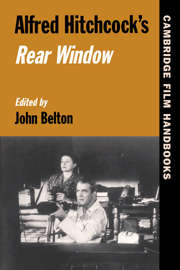Book contents
- Frontmatter
- Contents
- Acknowledgments
- List of Contributors
- Introduction
- 1 The Making of Rear Window
- 2 Voyeurism and the Postwar Crisis of Masculinity in Rear Window
- 3 “The Dresses Had Told Me”
- 4 Alfred Hitchcock's Rear Window
- 5 Eternal Vigilance in Rear Window
- Filmography
- Reviews of Rear Window, 1954
- Select Bibliography
- Index
3 - “The Dresses Had Told Me”
Fashion and Femininity in Rear Window
Published online by Cambridge University Press: 05 June 2012
- Frontmatter
- Contents
- Acknowledgments
- List of Contributors
- Introduction
- 1 The Making of Rear Window
- 2 Voyeurism and the Postwar Crisis of Masculinity in Rear Window
- 3 “The Dresses Had Told Me”
- 4 Alfred Hitchcock's Rear Window
- 5 Eternal Vigilance in Rear Window
- Filmography
- Reviews of Rear Window, 1954
- Select Bibliography
- Index
Summary
“They were a woman's dresses, and he was pulling them down to him one by one, taking the topmost one each time. … I knew what it was now, and what he was doing. The dresses had told me. He confirmed it for me.” The Cornell Woolrich short story on which Rear Window was based deploys costume at a key point as Jeff becomes more and more curious about Lars Thorwald and his invalid wife whose dresses are being packed into a trunk, possibly for a trip, but later confirming her mysterious disappearance. Apart from this notable incidence of costume being used to substantiate Jeff's eventual conclusion that Mrs. Thorwald has been murdered, the short story does not feature costume or accessories as significant character, plot, or symbolic devices. The dresses tell a simple story. Hitchcock's Rear Window, on the other hand, displays clothing on many occasions, functioning as a complex system. Intriguing possibilities are created for all the characters via their costumes, particularly Lisa (Grace Kelly) who does not appear in the short story but whose dresses, bags, and jewels tell a fascinating story that far exceeds the simple imperatives of plot development. This chapter discusses five major areas in which the film's costumes and accessories perform significant roles: narrative development, the delineation of gender relations, the articulation of the class theme, star images and the development of the “masquerading blonde,” and finally the role of costume in the film's authorship.
- Type
- Chapter
- Information
- Alfred Hitchcock's Rear Window , pp. 91 - 109Publisher: Cambridge University PressPrint publication year: 1999



